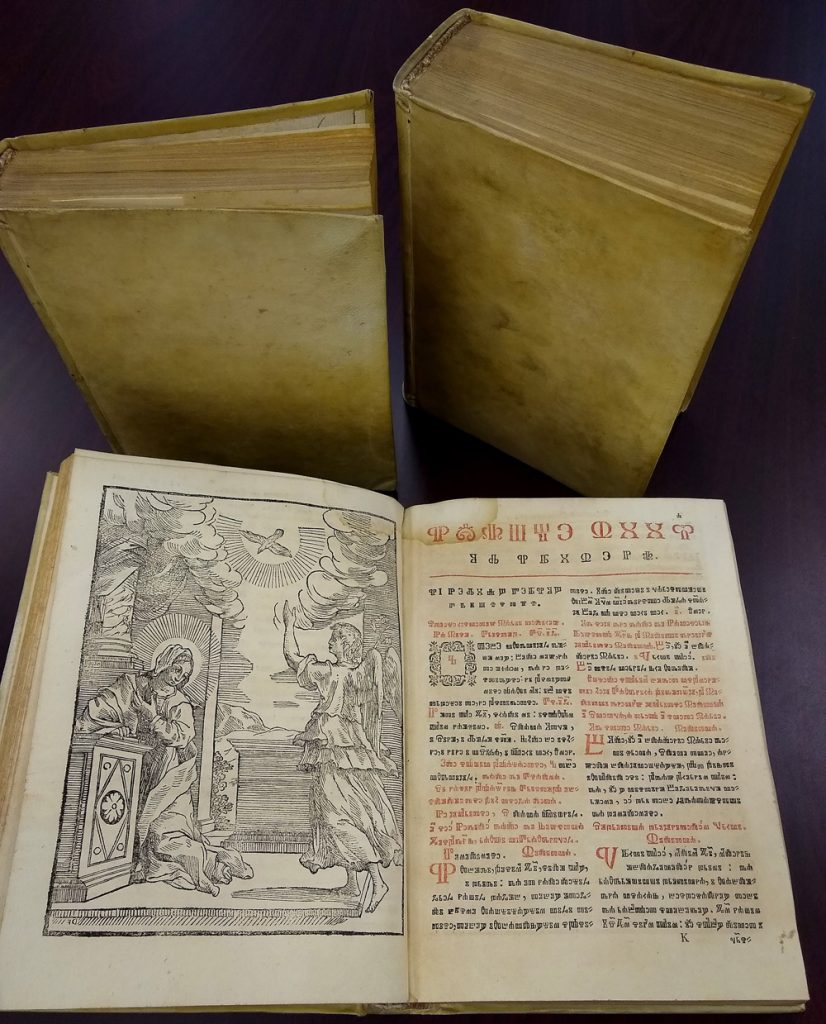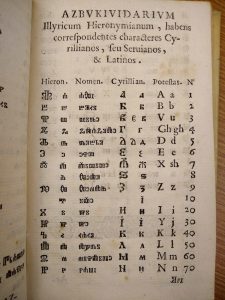– How many languages does the Church speak?
– All of them.
(a Sunday school joke)

By proclaiming being “Catholic” (meaning “universal”), the Catholic Church highlights its missionary effort to bring the light of the Gospel to every corner of the world and all nations. And often, there’s no other way to reach a community except by learning the language it speaks and the traditions it follows.
Such universality is evident to anyone browsing stacks in Mullen Library with books in various languages, both modern and ancient, usually well-known and spoken or studied today. In Rare Books, though, visitors may encounter volumes that can deeply puzzle any enthusiast willing to identify, not to mention – study them closely. Among them, there are several humbly-looking 17th and early 18th-century volumes that are part of the Clementine library, one of the crown jewels of our collection.
These volumes intrigue and raise questions. What script is that? What language? Who were these books meant for and what’s their purpose? Is it one of the mysterious languages, like the famous Voynich Manuscript, or an example of the “invented” ones like Tolkien’s Quenya or Star Trek’s Klingon? Are there nations that use it still? For most, it won’t look familiar at all, except maybe for some fans of modern video games, who may say that it definitely rings a bell. (Spoiler alert: They are not mistaken!)

Our volumes are maybe less mysterious, but they will definitely require deciphering skills. The oldest of them were printed in Rome in the 1630s-1640s at the press of the Congregation of Propaganda Fide (today – Dicastery for Evangelization), and the texts they contain, are in a local version of the Old Slavic language, used in the territory of modern Croatia. Most of them are printed in the script called Glagolitic, an older brother of the Cyrillic and one of the two main writing systems of Slavic nations. Today the Glagolitic is rather extinct.
Glagolitic Script
Whether invented by the holy brothers and missionaries Cyril and Methodius in the 9th century as a writing system for Slavs, as it’s commonly believed by Eastern Christians or, according to an old Western tradition, by St. Jerome, native to Dalmatia, who may also have translated the Bible in his native tongue using “Alphabetum Hieronimianum”, it still remains a mystery what Glagolitic was inspired by and whether it was just an act of pure invention of a brand new and unique writing system for an already existing spoken language.

Soon, Glagolitic was followed, and ultimately, replaced by Cyrillic, a more familiar and easy-to-use script. But it managed to survive in some territories until the 19th century and was revived recently to be used as a script within the “Witcher” video game series, based on the fantasy universe created by Polish writer Andrzej Sapkowski.
Latin and vernacular languages
Contrary to popular belief, Latin was not the only official language of the Roman Rite in the Catholic Church before the Second Vatican Council. At various times, missionary efforts required using other scripts and languages of nations the Church tried to reach and teach, and such practice was not reserved by Rome for only some “far away” lands, labeled on maps as “here be dragons”, but also for the nations right across the Adriatic Sea.
This set of volumes, preserved and accessible today in University Libraries’ Rare Books, was meant to be used among the people in Dalmatia and Croatia. It consists of a few primary liturgical books revised, approved, and published soon after the Council of Trent.
Missale Romanum Slavonico idiomate (Rome, 1706)
The first one to be published was the “new and corrected” Roman Missal in the Old Slavic language (also called Illyric in Rome). It was translated by a Croatian priest (later – bishop) Rafael Levaković, O.F.M. and was printed in 1631 in Glagolitic by order of Pope Urban VIII. Our copy is the 2nd revised edition of the Missal, published in Rome in 1706.
Missale Romanum Slavonico idiomate iussu S.D.N. Urbani Octavi editum… Romae, typis Sac. Congreg. de Propaganda Fide, 1706 (2nd revised edition).
Call number: CL 264.6 M678
Breviarium Romanum Slavonico idiomate (Rome, 1688)
The Roman-Illyrian Breviary was the second volume to be published by the same translator. It came out of the printing press in 1648, after a long editorial process initiated by the Congregation of Propaganda Fide, which required the psalms to be consistent with the newly approved text of the Latin Bible. Our copy is the second printing of 1688.
Breviarium Romanum Slavonico idiomate iussu S.D.N. Innocentii PP. XI editum… Romae, typis & ompensis Sac. Congreg. de Propaganda Fide, 1688.
Call number: CL 264.3 B846S 1688
Rituale Romanum [Illyrica lingua] (Rome, 1706)
Meanwhile, the Rituale Romanum, another important liturgical volume, was translated. This time, by a Jesuit Bartol Kašić (1575-1650) and not into the ancient Old-Croat-Slavonic, but into the vernacular. According to scholars, this edition “marks the beginning of the standardization of the Croat literary language” [1].
The volume was published in Rome in 1640 and, after a period of discussion and consideration, in Latin script. Nevertheless, this book is part of the same corpus of liturgical books published for Christians in Croatia by the Congregation of Propaganda Fide.
Rituale Romanum Urbani VIII, Pont. Max. issue editum. Illyrica lingua… Romae, Ex typographia Sac. Congreg. de Propaganda Fide, 1640.
Call number: CL 264.12 R615
Azbukidarium Illyricum Hieronimianum (Rome, 1693)
An additional item in our Glagolitic collection is a small pamphlet that serves as an introduction to the script and language. It contains both the Glagolitic and Cyrillic versions of the alphabet, some basic words, abbreviations, and a few popular prayers. One can assume, it may have been a starting point for everyone willing to get familiar with the language.
Azbvkidarivm Illyricum Hieronimianum, habens correspondentes characteres Cyrillianos, seu Seruianos, & Latinos, Romae, Typis Sacrae Congr. De Propaganda Fide, 1693.
Call number: CL 411 A456.
Research value
These books are not just another curiosity in our collection. Their unique content may be of interest to scholars of a range of disciplines, from church history and liturgy to Eastern European language and history studies.
The researchers willing to study them deeply will have to face countless questions about their history and purpose, translation techniques and language features, relationships between Western and Eastern Christians, missions among non-Catholics, such extinct traditions as Glagolitic and Aquileyan liturgical rites, and more.
One of the mysteries that puzzle our staff members is the controversy around the Slavic Psalter printed with the Breviary. The original, and rather standard text of the Psalter, commonly used by Eastern Orthodox Churches, was rejected by Rome, and a committee was established with a Ukrainian Catholic Bishop Methodius Terleckyj as its head with the task to review the text and make it consistent with the promulgated text of the Latin Vulgate. But how many corrections were made and how significant they were? How much the revisions were influenced by Ukrainian liturgical tradition [2]? These are some of the many intriguing questions one can encounter while approaching these volumes. And only they can provide an answer and help us to know our past better.
These books can be accessed by appointment in Rare Books (Mullen 214, lib-rarebooks@cua.edu) by any patron or researcher interested in studying them more closely.
Sources:
Thomson, F.J. (2005). The legacy of SS. Cyril and Methodius in the Counter-Reformation: The council of Trent and the question of scripture and liturgy in the vernacular, together with an account of the subsequent consequences for the Slavo-Latin (Glagolitic) rite and the Bible in Croatian translation. In E. Konstantinou (Ed.), Methodios und Kyrillos in ihrer Europäischen Dimension (Philhellenische Studien, 10)(pp. 87-246). Peter Lang. doi:10.1017/S0022046906429882, http://www.europa-zentrum-wuerzburg.de/unterseiten/Band10-Thomson.pdf
Žubrinić, D. (2009). Hrvatska glagoljička kultura s osvrtom na Francusku. Croatia: Overview of history, culture, and science. https://www.croatianhistory.net/etf/francegl.html
References:
[1] Thomson, 2005, p. 82.
[2] See Thomson, 2005, p. 78.
